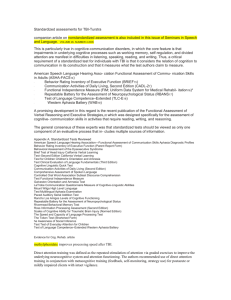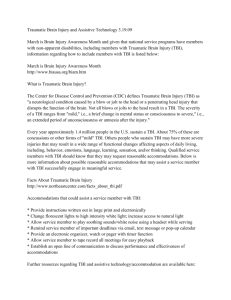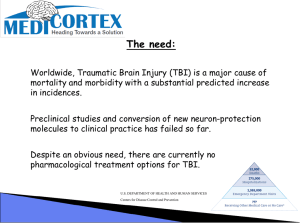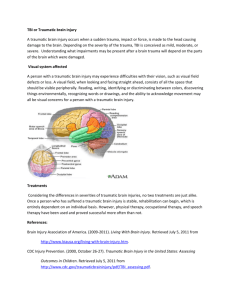New Special Issue (2004) Journal of Head Trauma Rehabilitation
advertisement
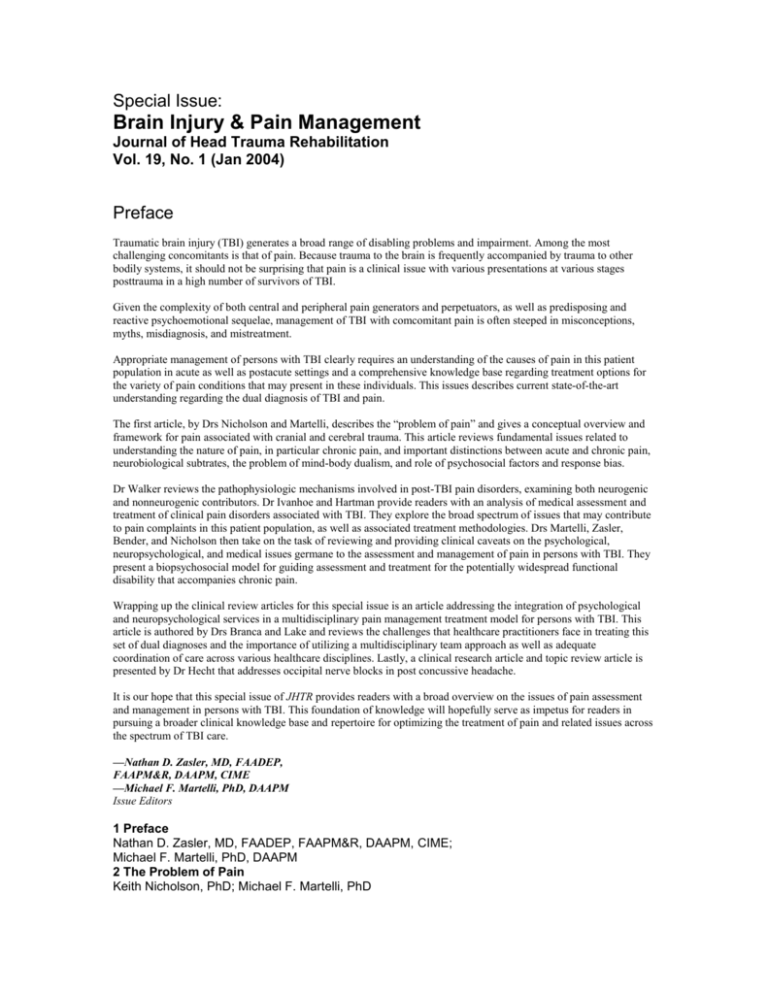
Special Issue: Brain Injury & Pain Management Journal of Head Trauma Rehabilitation Vol. 19, No. 1 (Jan 2004) Preface Traumatic brain injury (TBI) generates a broad range of disabling problems and impairment. Among the most challenging concomitants is that of pain. Because trauma to the brain is frequently accompanied by trauma to other bodily systems, it should not be surprising that pain is a clinical issue with various presentations at various stages posttrauma in a high number of survivors of TBI. Given the complexity of both central and peripheral pain generators and perpetuators, as well as predisposing and reactive psychoemotional sequelae, management of TBI with comcomitant pain is often steeped in misconceptions, myths, misdiagnosis, and mistreatment. Appropriate management of persons with TBI clearly requires an understanding of the causes of pain in this patient population in acute as well as postacute settings and a comprehensive knowledge base regarding treatment options for the variety of pain conditions that may present in these individuals. This issues describes current state-of-the-art understanding regarding the dual diagnosis of TBI and pain. The first article, by Drs Nicholson and Martelli, describes the “problem of pain” and gives a conceptual overview and framework for pain associated with cranial and cerebral trauma. This article reviews fundamental issues related to understanding the nature of pain, in particular chronic pain, and important distinctions between acute and chronic pain, neurobiological subtrates, the problem of mind-body dualism, and role of psychosocial factors and response bias. Dr Walker reviews the pathophysiologic mechanisms involved in post-TBI pain disorders, examining both neurogenic and nonneurogenic contributors. Dr Ivanhoe and Hartman provide readers with an analysis of medical assessment and treatment of clinical pain disorders associated with TBI. They explore the broad spectrum of issues that may contribute to pain complaints in this patient population, as well as associated treatment methodologies. Drs Martelli, Zasler, Bender, and Nicholson then take on the task of reviewing and providing clinical caveats on the psychological, neuropsychological, and medical issues germane to the assessment and management of pain in persons with TBI. They present a biopsychosocial model for guiding assessment and treatment for the potentially widespread functional disability that accompanies chronic pain. Wrapping up the clinical review articles for this special issue is an article addressing the integration of psychological and neuropsychological services in a multidisciplinary pain management treatment model for persons with TBI. This article is authored by Drs Branca and Lake and reviews the challenges that healthcare practitioners face in treating this set of dual diagnoses and the importance of utilizing a multidisciplinary team approach as well as adequate coordination of care across various healthcare disciplines. Lastly, a clinical research article and topic review article is presented by Dr Hecht that addresses occipital nerve blocks in post concussive headache. It is our hope that this special issue of JHTR provides readers with a broad overview on the issues of pain assessment and management in persons with TBI. This foundation of knowledge will hopefully serve as impetus for readers in pursuing a broader clinical knowledge base and repertoire for optimizing the treatment of pain and related issues across the spectrum of TBI care. —Nathan D. Zasler, MD, FAADEP, FAAPM&R, DAAPM, CIME —Michael F. Martelli, PhD, DAAPM Issue Editors 1 Preface Nathan D. Zasler, MD, FAADEP, FAAPM&R, DAAPM, CIME; Michael F. Martelli, PhD, DAAPM 2 The Problem of Pain Keith Nicholson, PhD; Michael F. Martelli, PhD 10 Psychological, Neuropsychological, and Medical Considerations in Assessment and Management of Pain Michael F. Martelli, PhD; Nathan D. Zasler, MD; Mark C. Bender, PhD; Keith Nicholson, PhD 29 Clinical Caveats on Medical Assessment and Treatment of Pain After TBI Cindy B. Ivanhoe, MD; Eric T. Hartman, MD 40 Psychological and Neuropsychological Integration in Multidisciplinary Pain Management After TBI Barbaranne Branca, PhD, ABPN, DABFE; Alvin E. Lake III, PhD 58 Occipital Nerve Blocks in Postconcussive Headaches: A Retrospective Review and Report of Ten Patients Jeffrey S. Hecht, MD 72 Pain Pathoetiology After TBI: Neural and Nonneural Mechanisms William C. Walker, MD The Problem of Pain Keith Nicholson, PhD; Michael F. Martelli, PhD Pain problems, especially posttraumatic headache, are very common following head trauma. Pain may be the most significant problem, more disabling than any brain or other injuries, and interfering with aspects of cognition or other function. However, posttraumatic headache and most other chronic posttraumatic pain problems remain poorly understood. This article reviews fundamental issues that should be considered in understanding the nature of chronic pain including the distinction between acute and chronic pain; neurobiological distinctions between the lateral and medial pain system; nociceptive versus neuropathic or other central pain; sensitization effects; the widely accepted view of chronic pain as a multidimensional subjective experience involving sensory, motivational-affective and cognitive-behavioral components; the problem of mind-body dualism; the role of psychosocial factors in the onset, maintenance, exacerbation or severity of pain; plus issues of response bias and malingering. Psychological, Neuropsychological, and Medical Considerations in Assessment and Management of Pain Michael F. Martelli, PhD; Nathan D. Zasler, MD; Mark C. Bender, PhD; Keith Nicholson, PhD Pain is a common yet challenging problem, particularly following traumatic injuries to the head or neck. It is a complex, multidimensional subjective experience with no clear or objective measures; yet it can have a significantly disabling effect across a wide range of functions. Persisting misconceptions owing to mind-body dualism have hampered advances in its understanding and treatment. In this article, a conceptualization of pain informed by recent research and derived from a more useful biopsychosocial model guides discussion of relevant medical, psychological, and neuropsychological considerations. This pain process model explains chronicity in terms of hyperresponsiveness and dysregulation of inhibitory or excitatory pain modulation mechanisms. Related neurocognitive effects of chronic pain are examined and recommendations for minimizing its confounding effects in neuropsyhological evaluations are offered. A biopsychosocial assessment model is presented to guide understanding of the myriad of factors that contribute to chronicity. A brief survey of general classes and samples of the more useful pain assessment instruments is included. Finally, this model offers a rational means of organizing and planning individually tailored pain interventions, and some of the most useful pharmacologic, physical, and behavioral strategies are reviewed. Clinical Caveats on Medical Assessment and Treatment of Pain After TBI Cindy B. Ivanhoe, MD; Eric T. Hartman, MD The diagnosis and management of pain in the patient with traumatic brain injury (TBI) can be difficult in light of the limitations imposed by the cognitive, language, and behavioral deficits. With patients in the acute rehabilitation setting, one must be vigilant for the often subtle signs and symptoms of pain. Causes more commonly seen in the population with TBI as a consequence of the injury itself include dysautonomia, neuropathic pain, spasticity, and heterotopic ossification. Headaches may be a consequence of TBI or associated with it for other reasons. Sources of pain associated with TBI include deep venous thrombosis and others. The reader is reminded that patients with TBI are subject to all the causes of pain that affect the general population. Psychological and Neuropsychological Integration in Multidisciplinary Pain Management After TBI Barbaranne Branca, PhD, ABPN, DABFE; Alvin E. Lake III, PhD The intersection of traumatic brain injury and posttraumatic chronic pain poses a significant challenge for the health practitioner. Effective intervention requires psychological and neuropsychological evaluation, multidisciplinary teamwork, and an understanding of a wide range of pain disorders and their relationship to traumatic brain injury. Assessment must include documentation of both current functioning and premorbid history. Pain interacts with cognitive impairment, mood and anxiety disorders, dysinhibition syndromes, and personality disorders, posing significant diagnostic dilemmas and treatment challenges. Coordinated care requires multiple, ongoing interventions from a variety of specialists. Patient involvement, focusing on internal locus of control, mediates successful treatment. Occipital Nerve Blocks in Postconcussive Headaches A Retrospective Review and Report of Ten Patients Jeffrey S. Hecht, MD Headaches are common following traumatic brain injuries of all severities. Pain generators may be in the head itself or the neck. Headache assessment is discussed. Diagnosis and treatment of cervical headaches syndromes and, in particular, occipital neuralgia are reviewed. Finally, a retrospective study of 10 postconcussive patients with headaches who were treated with greater occipital nerve blocks is presented. Following the injection(s), 80% had a “good” response and 20% had a “partial” response. Occipital nerve block is a useful diagnostic and treatment modality in the setting of postconcussive headaches. Pain Pathoetiology After TBI Neural and Nonneural Mechanisms William C. Walker, MD Individuals recovering from traumatic brain injury (TBI) frequently experience acute and chronic pain. Their pain experience is the net effect of many interacting and very complex physiologic, biochemical, and psychological mechanisms involving both the peripheral and central nervous system. This article reviews the basics of neural mechanisms and pathways of pain after TBI, and discusses clinical implications. Numerous intracranial and extracranial tissues must be considered in the evaluation of pain after TBI, with the specific mechanism of trauma influencing the anatomic distribution of injuries. The differential diagnosis usually falls into one of the following pathoetiologic classifications: primary or secondary musculoskeletal, vascular, visceral, and neural pain syndromes. TEASER… “Finally, the standards for specialty knowledge and training for treating pain parallel those for treating brain injury.91 Similar expectancies apply to both, and neither should be compromised. At the core of all bioethical principles is the avoidance of harm. Virtually every ethics code issued by every healthcare profession and specialty enjoins its members to avoid doing harm by not practicing outside the limitations of their competence. Consistent with recent revisions and current ethical principles in medicine and psychology,92–94 available options for brain injury specialists without specialized training and experience in pain management include referral to a professional with specialty competence; consultation with such specialists when referrals cannot be made; and acquisition of knowledge, supervision and training as indicated. When professions provide pain management services in the absence of specialty competence and without availing themselves of these options, they have ethical obligations to represent these limitations through tentativeness in opinions and conclusions and with complete transparency about the potential effects of these limitations.”
